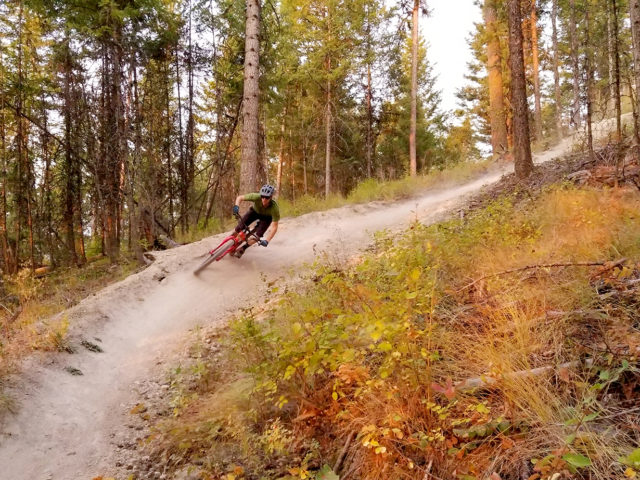
Race Face Turbine R Dropper Post
Configuration Tested: 30.9 diameter, 150 mm length
Blister’s Measured Weight:
- Post only: 589 grams
- Lever with perch: 68 grams (w/o cable and housing)
MSRP:
- Post: $294.99
- 1x Lever: $69.99
Mounted to: 2018 Trek Slash
Reviewer: 5’9”, 150 lbs
Test Locations: Montana; British Columbia
Test Duration: ~3 months
Intro
Race Face’s Turbine R dropper is built around the internals used in the Fox Transfer post, which has been around for a little while now and has generally been pretty well received. This also means the Turbine R post is quite a bit different than Race Face’s Turbine dropper post, which uses completely different internals that are licensed from 9point8.
I spent a bunch of time on the Turbine post, and while it has a bunch of upsides, it was also a bit tricky to get it working correctly and consistently. Race Face has tweaked the Turbine since then, but I was interested to get on the Turbine R to see if it was similarly fussy.
Well, I’ve put a bunch of time on the Turbine R this summer, including lots and lots of raisings and lowerings. And I can say this: it’s not fussy. At all. It just works.
Measurements, Features, and Options
The Turbine R is available in 150, 125, and 100 mm drops, in both 30.9 and 31.6 mm diameters. All posts have a zero-offset head, and all posts use internal cable routing.
Race Face lists the total post lengths as 456, 406, and 356 mm for each respective drop length. However, on the 150 mm Turbine R I tested, I measure it to be about 26 mm longer than its stated length to the very bottom of the actuator measurement that sticks out the bottom of the post. When fully extended, the distance from the centerline of the seat rails to the bottom of the seal collar is about 206 mm, meaning that if you stick the post all the way into the frame, your saddle rails will be 206 mm from the top of the seat tube. That number would be 25 or 50 mm shorter with the 125 or 100 mm posts, respectively.
Race Face is up front about the fact that the Turbine R’s internals are the same as the Fox Transfer post, although it doesn’t have an option for a Kashima slider. Tom Collier’s review of the Transfer gets into the nitty gritty of the internals, but the short version is that the Turbine R uses a fairly traditional air and oil mechanism to move the post and lock it in place, but it has a few slick features around the valving to make the post move more smoothly and improve on durability.
In terms of the more visible features, the Turbine R is simple but effective. A standard two-bolt head makes saddle angle adjustments easy and secure, although I found that the wedged washers were right at the limit of the angles they could handle with the slack seat tube of the Trek Slash I had the Turbine R mounted to.
The Turbine R’s lever actuation is mechanical, and uses a simple pinch bolt at the post end to attach the cable. Detaching the cable to remove the post is easy, and I never had any issues with the cable slipping or coming detached when I didn’t want it to.
My Impressions
Normally I’d title this section “the ride,” where I’d talk about how the component rides. But this is a seatpost. If everything is going well, it just kinda holds the seat there, and when I push a button, it makes the seat get out of the way. And to be clear, the Turbine R definitely does that. But there are more interesting things to talk about here, so rather than waste 400 words talking about a seatpost going up and down, let’s cut to the chase.

Dropper posts are somewhat notoriously prone to failure. There are a bunch of different ways to go about making a seat go up and down — hydraulic, mechanical, hybrid (hydraulic and mechanical), and a ton of variations on all of those options. But every post design has one downside or another. For a hydraulic post like the Turbine R, the traditional downsides are (1) cost, (2) durability, and to a lesser extent, (3) weight.
Cost
In terms of cost, the Turbine R is pretty average among name-brand posts — it’s comparable to posts from Rockshox, Specialized, and KS, it’s a bit cheaper than posts from Thomson or 9point8, and it’s a bit more expensive than an assortment of generic-ish options on the market. At any given time, you might be able to find some of those posts on sale, but in terms of currently produced dropper post models, the Turbine R is neither notably expensive nor notably cheap.
Durability
In terms of durability, my Turbine R has been flawless. Yes, this is a sample size of one, but I’ve treated it like shit. I pick the bike up by the seat with the dropper post down. I hang the bike by the seat with the dropper down. I don’t clean it. And when I do, I point the hose at the seals. I’ve landed drops in the saddle. I’ve taken it up and down significant elevation changes. It’s been in the snow, and it’s been in 100+ degree temperatures. Basically, I’ve done all of the things that would contribute to a hydraulic dropper post’s premature failure.
But it’s still perfect. It raises smoothly with the same gentle clunk at the top of its travel that it had on day one. It goes down smoothly without any scrapey or gurgly sounds. There is absolutely zero vertical give to the saddle — it’s not spongy at all. And the bushing slop that allows for a tiny bit of saddle rotation is still negligible — it’s tighter than most other posts on the market.
Weight
That brings us to potential downside number 3: weight. The Turbine R is pretty average in this respect. It’s comparable to a Rockshox Reverb, but a bit heavier than some options from KS, Thomson, and others. Race Face’s Turbine dropper is also a bit lighter. In other words, the Turbine R isn’t noteworthy in it’s lack of, or excess of heft.
Race Face 1x Lever
The one thing that is worth mentioning while actually riding is the dropper lever. Race Face makes a couple different levers, but I was using their 1x lever, and I like it. It sits in place of the component formerly known as the front shifter, and it’s shaped exactly like a Sram shifter. Most noteworthy is the fact that the perch is shaped right, meaning that it doesn’t interfere with the brake lever and create a situation where both the dropper lever and brake lever need to be clamped to the exact same place on the bar in order for my completely average fingers to reach them, which is a dumb situation that seems to come up far too often and I’m perpetually annoyed by it. But the Race Face 1x lever doesn’t have that problem, so kudos to Race Face on that one.

I’ll also say that I like the Race Face 1x lever significantly more than the one that comes with the Fox Transfer. The Race Face 1x is a bit bigger, and easier to get a thumb on while bouncing around on a rough trail.
Bottom Line
Can I wrap this up with a paragraph entirely composed of review cliches? “Takes a licking and keeps on ticking.” “3 months isn’t long enough to arrive at a definitive conclusion on durability, but so far it’s been great.” “My Turbine R seatpost is the highlight of my mountain biking experience.”
Ok, that last one maybe hasn’t quite become cliche yet.
But yes, I’m impressed by the Turbine R. If we measure dropper-post reliability in Reverbs, I’d say the Turbine R has thus far lasted 2 Reverbs. Maybe 3. And just to reiterate, the Turbine R has lasted 2 Reverbs with zero maintenance or fussing — I set it up, and haven’t touched it since then. Not even a cable tension adjustment. So if you’re sick of dropping dinero on droppers that don’t cut the mustard, the Turbine R is a solid bet.
